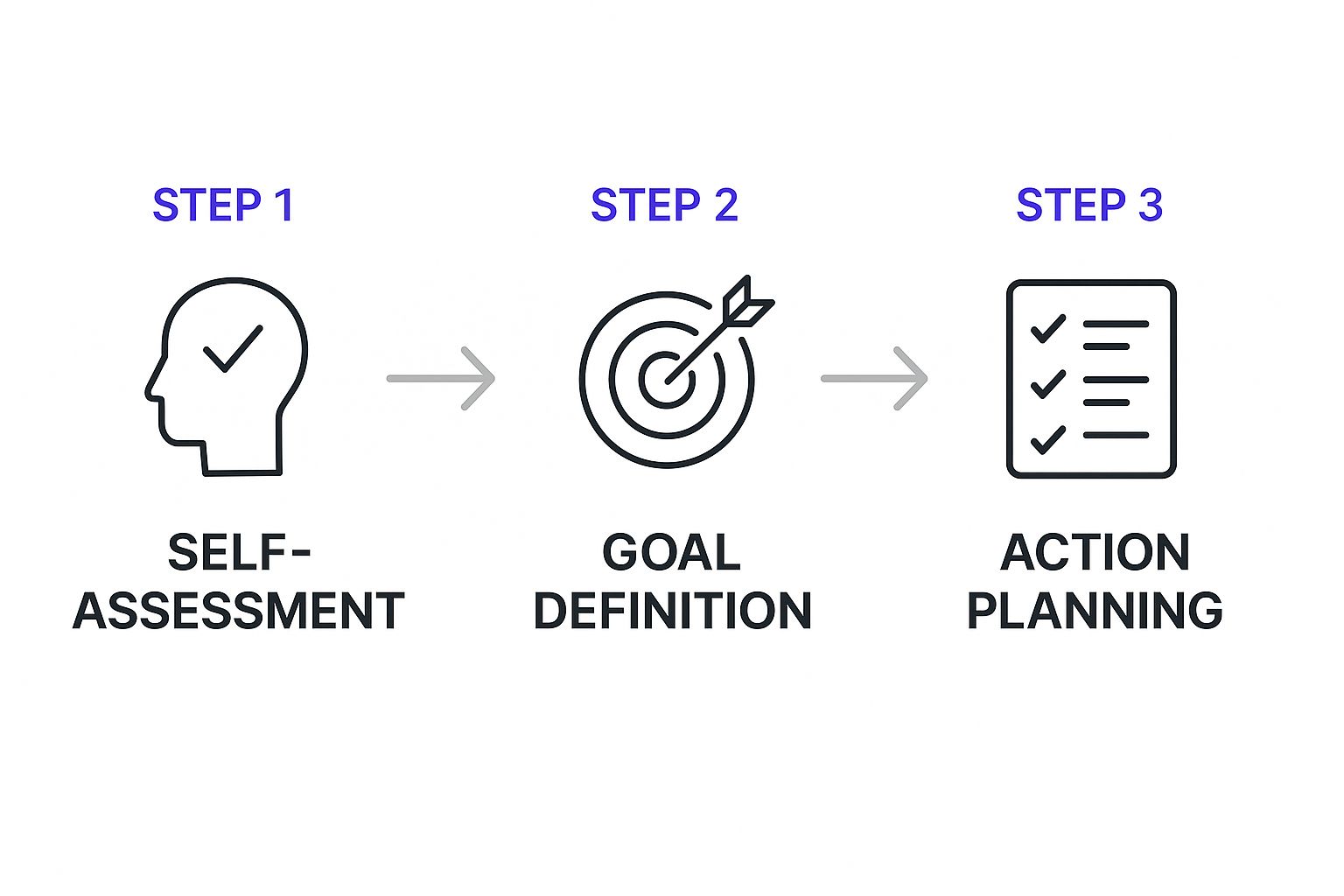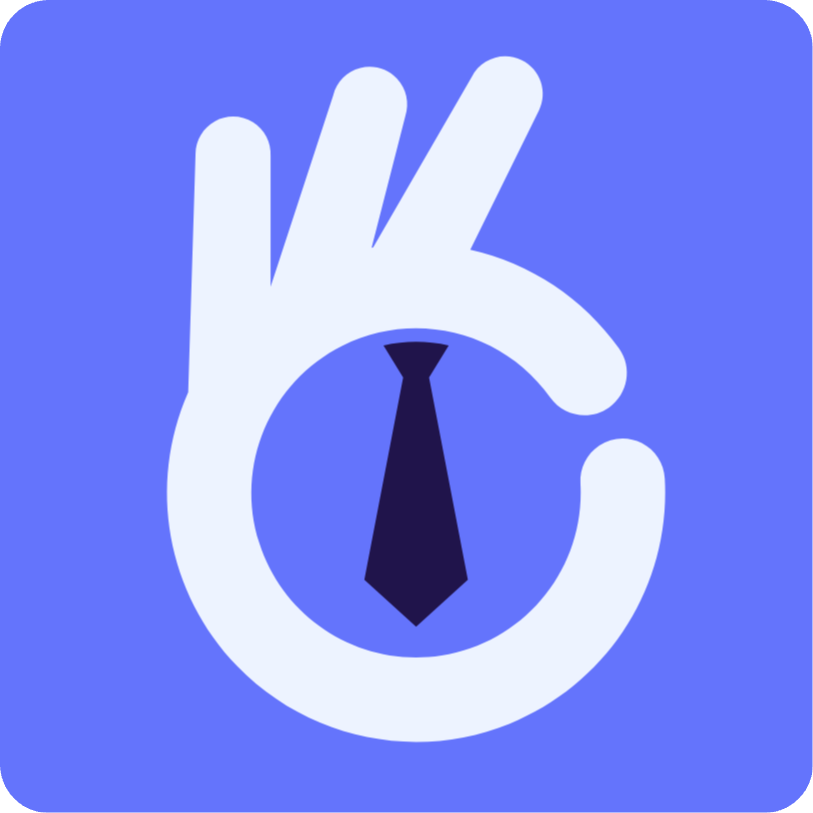A Career Development Plan Template for Your Future
Think of a career development plan template as more than just a document—it's your personal roadmap. It’s what turns those fuzzy professional daydreams into concrete, actionable steps. It helps you map out your goals, pinpoint any skill gaps, and figure out exactly what you need to get ahead.
Why You Need a Career Development Plan Now

Let's get real for a second. A career plan isn't some corporate checkbox you tick off during your annual review. It’s the critical difference between letting your career happen to you and actively building a career that you actually find fulfilling.
Having a simple plan gives you a framework for making smart, purposeful decisions. It ensures every move—whether it's learning a new software, volunteering for a tough project, or just grabbing coffee with a mentor—is a deliberate step forward. This isn't just about moving faster; it's about taking the reins of your own professional story.
The Real Impact on Satisfaction and Retention
The data doesn't lie. When you have a plan, you feel better about your work. Studies show that employees with clearly defined career goals report a 20% higher level of job satisfaction than those who are just winging it.
It's a big deal for companies, too. Organizations that genuinely invest in their employees' growth can see retention rates jump by as much as 30%. People stick around when they feel like they have a future.
This isn't just about chasing a bigger title. It’s about building a work life that feels right. A plan brings clarity, and clarity cuts down on stress and builds confidence. You can finally focus your energy where it truly counts.
Core Components of an Effective Career Development Plan
A truly solid career plan isn't just a list of wishes. It's built on a few key pillars that work together to guide your professional journey. Each piece has a specific job, creating a document that’s both inspiring and incredibly practical.
Here is a breakdown of the essential elements that form a robust and actionable career development plan.
| Component | Purpose | Example Action |
|---|---|---|
| Self-Assessment | To create an honest baseline of your current skills, strengths, and areas for improvement. | List your top 3 professional strengths and 2 skills you need to develop in the next year. |
| Career Vision | To define your "North Star"—a clear picture of your long-term ideal professional self. | Write a short paragraph describing your ideal role and work environment in 5 years. |
| Goal Setting | To break down your vision into measurable, time-bound objectives. | Set a short-term goal to complete a project management certification in 6 months. |
| Action Plan | To outline the specific, tactical steps required to achieve each goal. | Identify 3 online courses and reach out to 2 mentors to support your certification goal. |
Ultimately, these components ensure your plan is well-rounded, covering everything from self-reflection to the nitty-gritty daily actions that will get you where you want to go.
Turning Your Vision into Action
Let's break down these core components a bit more.
- Self-Assessment: This is where you start. It’s about taking a really honest look in the mirror. What are you great at? Where do you struggle? What parts of your job actually excite you? This gives you a solid starting point.
- Career Vision: This is your big-picture dream. It’s more than just a job title; it’s about what you want your professional life to feel like. Where do you see yourself in five or ten years?
- Goal Setting: Now, we make that vision real. You'll break it down into tangible, measurable goals. Think short-term wins (like completing a certification in 6 months) and long-term ambitions (like landing a senior leadership role in 5 years).
- Action Plan: This is the most crucial part—the "how." You'll list the exact steps, resources, and timelines to hit your goals. Strong networking is almost always part of the plan, and you can get some great ideas from our guide on effective job search networking to build those vital connections.
A career plan is your personal business plan for your professional life. It provides the strategy, milestones, and metrics needed to manage your most important asset: your career.
Defining Your Personal Career Vision

Before you even think about filling out a template, you need a destination. A clear, compelling vision is the engine of any career plan; it’s the "why" that fuels your ambition and keeps you going when things get tough.
This is about much more than a job title or a salary figure. Your vision is your professional north star. It’s a vivid picture of the impact you want to make, the kind of environment you thrive in, and the values you refuse to compromise on.
Figuring this out is a crucial first step. It often involves exploring how to find your passion and build a life you love to make sure your goals are genuinely yours, not just what you think you should want.
Conduct a Personal SWOT Analysis
To build an authentic vision, you need an honest starting point. I’ve found that a personal SWOT analysis is a straightforward yet incredibly powerful tool for this kind of self-reflection. It forces you to take stock of your internal landscape and the external environment you’re operating in.
Grab a notebook and brainstorm answers to these four questions:
- Strengths: What are you naturally good at? Think about both hard skills (like proficiency in a programming language) and soft skills (like your knack for de-escalating tense meetings). What do people consistently praise you for?
- Weaknesses: Where do you have room for improvement? This isn’t about beating yourself up; it’s about honest assessment. Maybe public speaking makes your palms sweat, or you know you need to get better with project management software.
- Opportunities: What’s happening around you that you can jump on? This could be a growing demand for a skill you already have, a new project at work that would stretch you, or even major industry trends.
- Threats: What external factors could hold you back? Maybe new technology is making some of your skills less relevant, or there's a flood of new talent in your field.
This analysis is a snapshot in time. It provides the raw, unfiltered data you need to build a vision that’s grounded in reality.
Your personal SWOT analysis isn't about judgment; it's about clarity. It's the data you need to build a career path that maximizes your strengths and navigates around potential obstacles.
Writing Your Vision Statement
Once you have your SWOT insights, you can start crafting a career vision statement that actually inspires you. This shouldn't read like some dry, corporate memo. It needs to feel personal.
Don't write: "I want to be a senior marketing manager."
Instead, try something like this: "In five years, I will be a strategic marketing leader known for building creative, data-driven campaigns that truly connect with people. I’ll be part of a collaborative and innovative team where I can mentor rising talent and constantly learn about what's next in digital."
See the difference? The second example is powerful. It’s packed with impact, values, and environment—the stuff that actually leads to professional fulfillment. Your vision statement becomes the ultimate gut-check for every decision and opportunity that comes your way.
Setting Goals That Drive Real Progress

Let's be honest: a plan without real, actionable goals is just a wish list. This is where your grand career vision gets its feet on the ground, turning big ambitions into a series of steps you can actually take.
It’s not enough to just list out what you want. You have to craft those goals in a way that builds momentum and shows you're actually moving forward.
The SMART framework is a classic for a reason, but too many people treat it like a boring acronym to check off. Think of it as a filter—one that separates vague daydreams from concrete objectives that will genuinely push your career ahead.
Going Beyond the SMART Acronym
What's the real point of setting goals? Clarity. A perfectly defined goal tells you exactly what to do next, eliminating the guesswork that so often leads to procrastination.
Which of these sounds more likely to get done?
- Vague Goal: "I want to get better at marketing."
- SMART Goal: "I will complete the Google Analytics for Beginners certification by the end of Q2 to sharpen my data analysis skills for our upcoming campaign launches."
The second one is a real goal. It’s Specific (Google Analytics certification), Measurable (completion), Achievable (it’s a beginner course), Relevant (for campaign analysis), and Time-bound (end of Q2). See how that gives you a clear starting point?
Your goals should be so clear that you could hand them to a colleague, and they would understand exactly what success looks like without asking a single follow-up question.
Breaking Down Your Vision Into Milestones
Staring at a five-year vision can feel paralyzing. The trick is to chop it up into smaller, less intimidating pieces.
Picture a pyramid. Your long-term vision is at the very top. It's supported by annual goals, which are in turn propped up by quarterly milestones, and finally, built on a foundation of weekly tasks.
Let's walk through an example. Say your five-year goal is to become a Product Manager.
- Year 1 Goal: Gain foundational product management experience and skills.
- Q1 Milestone: Complete a PM certification course online.
- Q2 Milestone: Volunteer to lead a small cross-functional feature enhancement at your current job.
- Weekly Task: Dedicate three hours every week to your course and schedule one coffee chat with a current PM.
This method transforms a distant dream into an immediate to-do list. It also creates a powerful feedback loop, letting you celebrate small wins that keep you motivated. Planning these steps is a huge part of being ready for your next opportunity; in fact, our guide on how to get hired faster drills down on why this kind of targeted prep work is so critical.
Performance Goals vs. Development Goals
A truly robust career development plan template needs two different kinds of goals: performance and development. They work together.
- Performance Goals (The "What"): These are all about results and outcomes. They’re directly tied to your job duties and what the business needs to achieve. An example would be: "Increase customer retention by 5% this quarter."
- Development Goals (The "How"): These are about building the skills and knowledge you need to hit those performance goals and advance your long-term vision. For example: "Master advanced Excel formulas by taking an online course this month to better analyze customer churn data."
Focusing on both ensures you're delivering value right now while actively building the skills you'll need for whatever comes next. This isn't just good for you; it's good for your employer. Companies that get this right often see employee productivity jump by an average of 15% in the first year alone. You can discover more insights about flexible employee development plans on edstellar.com and see how other companies put this into practice.
Alright, you've got your goals mapped out. Now for the tough part: a brutally honest look at what you can actually do right now.
Identifying your skill gaps isn't about beating yourself up over what you don't know. It's about building a strategic bridge from where you are to where you want to be. Your career development plan template is useless without this crucial step.
We're not just talking about the technical skills on a job description, either. Think about the soft skills that make people truly successful—negotiation, managing difficult clients, or speaking confidently in a big meeting. Those are often the real game-changers.
Pinpointing Your Development Needs
First things first: pull up job descriptions for the roles you're aiming for in the next two to five years. Don't just skim them. Really dig in and make a list of the skills that pop up again and again, both technical and personal.
Got your list? Now, rate yourself. Be honest. A simple 1-5 scale for each skill will do the trick. This isn't about judgment; it's about clarity. The skills with the lowest scores are your starting line.
To get a real leg up, you'll want to focus on upskilling, which is a more structured way to build new competencies. You can learn more about upskilling to see how it can put your career progress on the fast track.
Creating Your Learning Agenda
With a clear picture of your gaps, you can build a learning plan that actually works. This isn't just a to-do list of courses. It’s a mix of different strategies to get you the skills you need.
- Formal Learning: Look for specific online courses, workshops, or certifications. Need to get better at data visualization? Find a targeted Tableau or Power BI course and sign up.
- Get Your Hands Dirty: Look for small, low-risk projects where you can practice a new skill. This could be at your current job or even a side gig. Nothing beats real-world application.
- Learn from the Pros: Find people who are already experts in the areas you want to improve. Buy them a coffee. Ask them questions. Their insights can save you a ton of time and mistakes. You might even discover that doing mock interviews with a mentor can reveal skill gaps you never knew you had, something we cover in our guide to https://www.eztrackr.app/blog/job-interview-practice.
This simple flow chart breaks down how to structure your efforts.

As you can see, solid career planning moves logically from self-assessment to setting goals and, finally, to taking action.
Bringing Your Career Plan to Life
So, you've put in the work and crafted a brilliant career development plan template. That’s a huge first step. But a plan is just a piece of paper (or, more likely, a file on your computer) until you actually do something with it.
The real challenge isn't creating the plan; it's making it a living, breathing part of your professional life. It’s all too easy to create a masterpiece of a document, feel super productive for a day, and then let it collect digital dust. Let’s make sure that doesn’t happen.
Weave Development Into Your Daily Routine
The secret to making your plan stick is to integrate it into your existing schedule, not to try and reinvent your entire week. Forget about finding a mythical four-hour block of free time on a Saturday—it probably doesn’t exist.
Instead, look for the small, consistent pockets of time you already have.
What does this look like in the real world? If one of your goals is to get smarter about your industry, could you swap 30 minutes of aimless social media scrolling for an industry newsletter during your lunch break? If you want to expand your network, can you schedule one 20-minute virtual coffee chat every other Friday?
These tiny, consistent actions are what build momentum. They compound over time and make progress feel natural, not like a chore.
Your career plan shouldn't feel like another heavy item on your to-do list. Think of it more like a compass, gently guiding your daily choices and helping you invest your time wisely.
Set a Cadence for Regular Check-Ins
A plan without a review cycle is a plan that's destined to get lost. You absolutely have to schedule regular check-ins to stay on track. This is your time to see what's working, figure out what's not, and make adjustments before you get too far off course.
I've found that a multi-layered review process works best:
- Weekly Gut Check (15 minutes): A quick, solo review. Did you do the small things you said you would? What's one tiny step you can take next week?
- Monthly Mentor/Manager Huddle (30-45 minutes): A more structured conversation. Share your wins, talk through your roadblocks, and get feedback on what's next.
- Quarterly Deep Dive (1-2 hours): This is where you zoom out. Take a hard look at your progress against your big-picture goals. Does the plan still make sense? Do you need to pivot for the next quarter?
This rhythm keeps you connected to your goals. And when your official performance review rolls around, you won't be scrambling for things to say. You'll walk in with a documented history of your growth, effort, and achievements, which makes asking for that raise or promotion a whole lot easier.
Stay Flexible and Roll With the Punches
Let's be real: life happens. Priorities at work will shift, a surprise project will land on your desk, and some goals you set will turn out to be less important than you originally thought. A rigid plan shatters under this kind of pressure. A flexible one just adapts.
When you hit a roadblock, don't view it as a failure. It’s just new information.
Maybe a particular skill you were focused on is no longer a company priority. That's okay. It’s a signal to pivot. Re-evaluate your action steps and redirect that time and energy toward something with a bigger payoff.
As you get closer to achieving your major goals, you might naturally shift into an active job search. Staying organized here is non-negotiable. A smart move is to use a dedicated job search tracker to manage applications and keep all your interview details in one place. Moreover, developing a comprehensive job search plan will give your search the structure it needs to be effective. Your career development plan is the bedrock that makes these focused efforts possible.
Frequently Asked Questions
It's totally normal to have questions pop up when you're putting together a career plan. Whether you're building your very first career development plan template or just dusting off an old one, getting the right answers is what turns a document into real-world progress.
How Often Should I Update My Career Development Plan?
Think of your plan as a living, breathing guide, not some dusty document you write once and forget.
A good rhythm is a quick check-in every quarter. This is just a light touchpoint to see how you're tracking against your short-term goals. Then, once a year, block off some time for a much deeper review. You should also do a full review anytime something big happens—a promotion, a move to a new company, or even just discovering a new interest that makes you rethink your future. The whole point is to keep it relevant to your actual life.
Can I Use This Plan If I Am Self-Employed?
Yes, and you absolutely should! For freelancers and entrepreneurs, a career development plan is even more essential. It's what helps you shift from just reacting to whatever project comes next to proactively building a business that lasts.
For anyone who's self-employed, the plan is your roadmap for figuring out:
- Service Offerings: Which of your skills are you going to build your business around?
- Target Clients: Who’s your dream customer, and how are you going to get in front of them?
- Income Goals: What are your real financial targets for the next 12 months?
- Skill Development: What new things do you need to learn to stay ahead and command higher rates?
This simple framework can turn your freelance hustle into a real, scalable business.
What Is the Most Important Part of the Plan?
Every piece of the plan has its place, but the real power comes from the connection between your big-picture vision and your small, actionable steps. It's the bridge that connects where you want to go with what you do today.
A big, inspiring vision without clear steps is just a daydream. But a list of tasks without a vision is just a grind with no purpose. The magic happens when you link them together.
When you can look at a small task on this week's to-do list and see exactly how it inches you closer to your five-year goal, you've tapped into the true power of career planning.
What If I Do Not Know My Long-Term Goals?
That's completely okay. In fact, it's incredibly common. Not knowing your final destination doesn’t mean you can’t start the journey. In this situation, the goal of your plan shifts from achieving to exploring.
If you’re foggy on the long-term stuff, just focus on the next 6-12 months. Set goals that are all about discovery.
Your action items might look more like this:
- Have coffee with people in three different industries that seem interesting.
- Sign up for a few short online courses in areas that spark your curiosity.
- Volunteer for a project at work that’s outside your normal duties to see how it feels.
Your plan becomes a tool for learning about yourself and what's out there. This process of trial and error is what will eventually bring that long-term vision into focus. Every step, even the ones that lead to a dead end, gives you valuable clues for what to do next.
Tired of juggling spreadsheets and losing track of your job applications? Take control of your career journey with Eztrackr. Our platform helps you save jobs from any board, track your progress on a visual kanban board, and build winning application materials with AI-powered tools. Join over 45,000 job seekers who are landing their next role faster. Start organizing your job search today at https://eztrackr.app.
 Interview Sidekick
Interview Sidekick